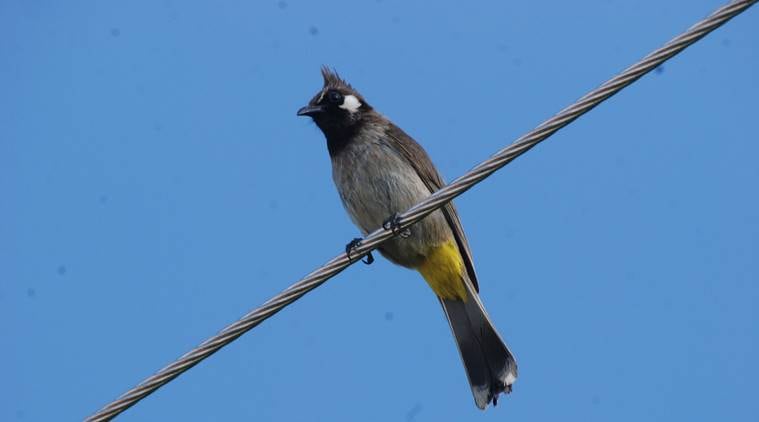 Perched view: Himalayan bulbuls with yellow bottoms. (Ranjit Lal)
Perched view: Himalayan bulbuls with yellow bottoms. (Ranjit Lal)
On a recent visit to Dehradun, I was staying at a small hotel on the outskirts, which abutted a wooded hillside on its western flank and a nullah on the east. Ahead, north and up on the mountain you could see the pinprick lights of Mussoorie at night. For a lazy birder, it was perfect: I would step out into the small balcony outside my room every morning and happily birdwatch in ideal conditions.
The first thing I noticed was that there were several very accomplished early morning songsters — unlike, say, in Delhi — where the magpie-robin is perhaps the only real star, when the brahminy myna is not performing. A lovely contralto song was the first to catch my attention: not as high-pitched as the magpie-robin’s, but gentler perhaps. At the edge of the roof of a nearby house, was the fluffed-up dusky artiste, dark and brown as a moth, and neat and demure: a brown rock chat. I made a note of its position and it delighted me on the following two mornings as well. On the third morning there was a white-browed wagtail pitching in. White-eyes, with their solemn expressions and white monocles jingled unseen in the foliage, like a constant background refrain, while sunbirds provided a few high-voltage moments of excited shrilling before zipping off.
There were others participating in the morning chorus, too. Perhaps, the most ubiquitous were the cheerful Himalayan bulbuls with their sunshine-yellow bottoms and court-jester crests, occasionally harried off by the ever pugnacious red-vented bulbuls. But there was more cacophonous belligerence by a gang of fluffed-up jungle babblers who bounced menacingly towards another one on the rock chat’s roof, catcalling rudely. It seemed as if a stray member of a rival gang had mistakenly landed up and was being shown his place: “Abbe baap ka chhath hai kya? Do you think this is your father’s roof?”
The richer, deeper and glossier colours of the birds there makes you wonder about what pollution is doing to the plumage of birds in places like Delhi. A jungle crow flew by, his inky feathers almost metallic black and the magpie-robin too looked like it was made out of obsidian and snow. The midnight inky blue of the Indian robin shone in the clear morning sunlight as he belted out a few notes. The somewhat guttural cooing of the spotted dove was another constant refrain — and seemed more attractive than the over-powdered beige collared doves. On a patch of open ground, just across the road, a pair of red-wattled lapwings patrolled like sentries — possibly they had a nest nearby though they didn’t get hysterical at any point — even when cattle bumbled into the place. Perhaps, they were just observing cantonment decorum.
By around 9 pm, a silence would descend on the hillside, only broken by the laboured roaring of beat-up trucks and buses toiling up the road that coiled up into the hills. Now was the time to scan the skies for raptors which would circle lazily and languidly. On the first morning, a buzzard of some kind turned up, with broad beige wings; on the third morning, there was a chocolate eagle — too high up for any positive identification — apart from its wedge-shaped tail. Grey hornbills flew across squealing, they didn’t look quite as shabby and dirty as the ones you met in Delhi. Scanning the trees on the hillside, you spot an old well-mannered but restless friend: the white-browed fantail. True to its name, the brownish-black and white bird — a little smaller than a bulbul — lands, bows and ducks and flares out its tail like a Japanese fan as if curtseying and taking a curtain call after a performance.
I’m, of course, saving the best for the last. On my third morning, in the small tree in front of my balcony, a small olive-grey bird with a bright yellow breast and throat and red beak showed up in a sudden flurry. Its black wings had fine yellow racing stripes. It was another old breathtaking acquaintance — the red-billed leiothrix. It zipped away almost immediately, only to be followed by another — and this one, the male, had crimson and red racing stripes along its sides, a more vivid yellow flare on its breast; it stuck out its chest in the manner of cocky bachelor sparrows and belted out a few sweet contralto bars even as I rushed into the room to grab the camera. I emerged only to see it whiz off as though it had performances to give all over the hillside and was running late — though frankly I think it was only chasing its girlfriend. When I checked the birds’ résumé, I was surprised to be reminded that this fastidious looking songster was a member of the usually disheveled garrulous, querulous and rather loud babbler clan. Well, I guess you can’t be responsible for who your relatives are.